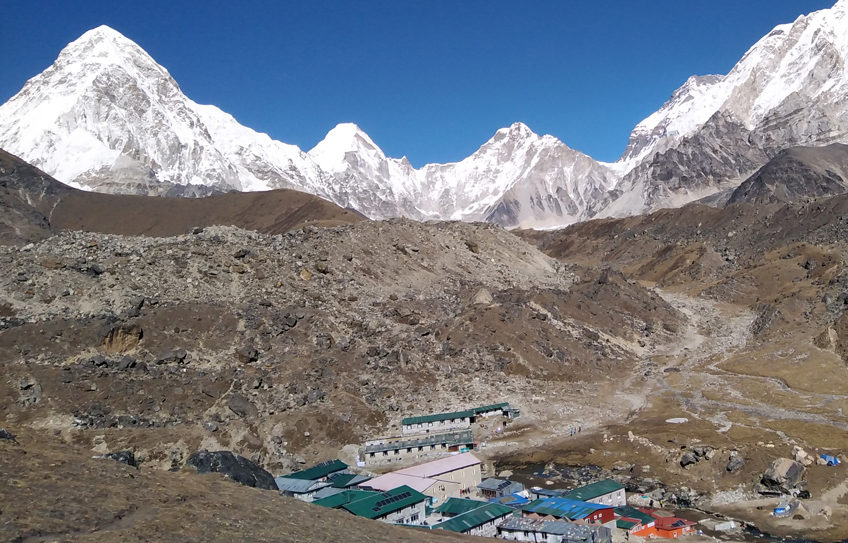Introduction:
Lobuche Peak is one of Nepal’s most sought-after climbing destinations, located in the iconic Khumbu region of the Himalayas. Standing at 6,119 meters (20,075 feet), Lobuche Peak offers a thrilling adventure for mountaineers and trekkers alike, providing breathtaking views of some of the world’s highest peaks, including Everest and Lhotse. This comprehensive guide will walk you through the essential information and preparation required for a successful and safe Lobuche Peak climbing expedition.
Part 1: Preparing for the Climb
- Physical Fitness: Climbing Lobuche Peak demands a good level of physical fitness and endurance. Engage in regular cardiovascular and strength training exercises, focusing on building stamina and acclimatization.
- Technical Skills: Familiarize yourself with basic mountaineering techniques, including using crampons, ice axes, and ropes. It’s advisable to have some prior experience in high-altitude trekking.
- Choosing the Right Season: The best time for Lobuche Peak climbing is during the pre-monsoon (spring) season (April-May) and post-monsoon (autumn) season (September-November) when the weather is stable and the skies are clear.
- Climbing Permits: Obtain the necessary permits from the Nepal Mountaineering Association (NMA). Check the latest permit fees, regulations, and required documents.
Part 2: Planning and Logistics
- Selecting a Trekking Agency: Choose a reputable trekking agency that offers Lobuche Peak climbing packages. Look for experienced guides, safety protocols, and good client reviews.
- Itinerary: Plan a well-structured itinerary that includes ample acclimatization days and contingency plans for adverse weather conditions.
- Accommodation: You have the option to stay in teahouses during the trek or camp in tents. Ensure that your chosen agency provides comfortable and reliable accommodations.
- Climbing Gear: Create a checklist of essential climbing gear, such as crampons, ice axes, harnesses, helmets, and climbing boots. Decide whether to rent or bring your own equipment.
- Insurance: Purchase comprehensive travel and medical insurance that covers high-altitude climbing, medical emergencies, and helicopter evacuation.
Part 3: The Climbing Expedition
- Acclimatization: Gradually ascend to higher altitudes to acclimatize your body and prevent altitude-related illnesses. Make sure your itinerary includes rest days for acclimatization.
- Base Camp: Reach Lobuche Peak Base Camp, usually situated at around 4,900 meters (16,076 feet). Here, your team will prepare for the climb and undergo a thorough briefing.
- High Camp: Ascend to High Camp, usually at an altitude of around 5,400 meters (17,716 feet), and spend a night there to further acclimatize.
- Summit Day: The final ascent begins before dawn to take advantage of stable weather conditions. Expect a challenging climb, but the breathtaking views from the summit will make it all worthwhile.
Part 4: Safety and Responsible Climbing
- Follow the Lead Guide: Always listen to your experienced climbing guide and follow their instructions to ensure your safety during the expedition.
- Leave No Trace: Respect the environment and practice responsible climbing by leaving no trash or waste behind. Follow the principles of “Leave No Trace” to preserve the natural beauty of the region.
- Stay Hydrated and Nourished: Drink plenty of water and eat nutritious food to maintain energy levels and prevent altitude sickness.
- Monitor Weather Conditions: Keep an eye on weather forecasts and be prepared to adjust your itinerary accordingly for safety reasons.
Part 5: Post-Climb Celebrations
- Congratulations and Reflection: Celebrate your achievement at the summit of Lobuche Peak. Take a moment to reflect on your journey and the remarkable experience.
- Return to Kathmandu: Descend back to Lukla and fly to Kathmandu. Take some time to explore the vibrant capital city and celebrate the successful climb with your team.
Conclusion:
Climbing Lobuche Peak is a thrilling and rewarding adventure, offering stunning vistas of the Himalayan landscape and a sense of achievement like no other. With proper preparation, a reputable trekking agency, and responsible climbing practices, you can make your Lobuche Peak expedition a safe and memorable experience of a lifetime. Remember to respect the mountains, follow safety guidelines, and cherish the majestic beauty of the Khumbu region.
